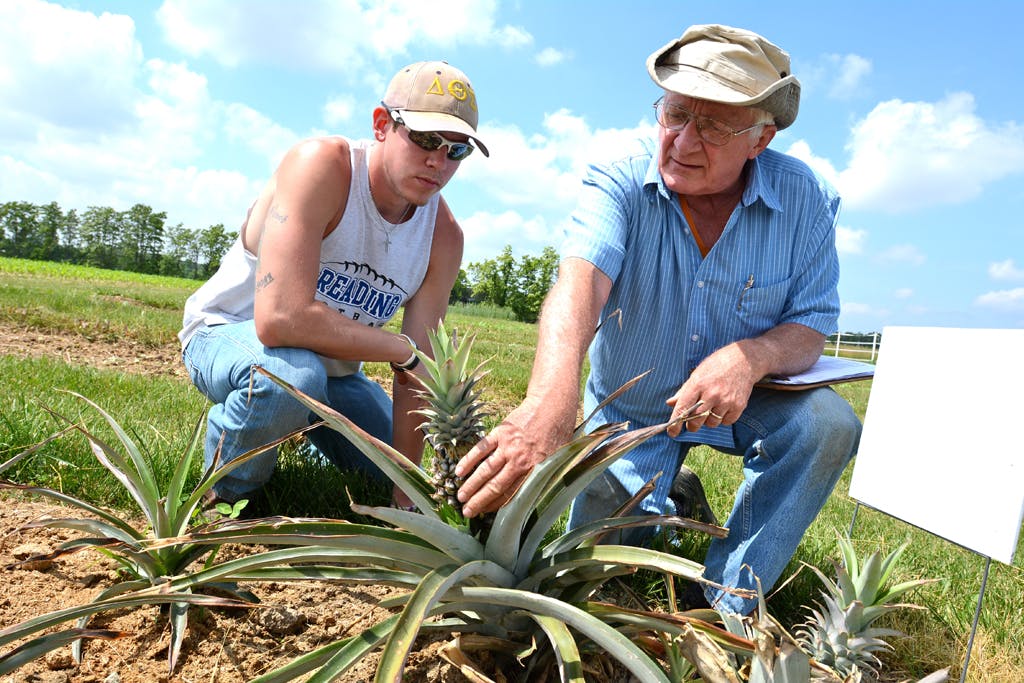At 73 Plots, It’s the Largest in the USA
Recent rains merely penetrated the top couple inches of soil so senior agriculture major Brandon Minor flooded a 4x12-foot plot of rice to better replicate its ideal growing conditions, while the Oaxaca green corn was doing fine under the hot June sun.
Now in its 13th year, the Living Crop Museum at Wilmington College features dozens of commercial agricultural crops grown in the United States — not just in Ohio and the Midwest but also from Maine to Arizona and Hawaii.
(LEFT) Agriculture professor Tom Stilwell shows agriculture major Brandon Minor elements of a plant not normally found in Ohio's fields — pineapple.
At 73 plots, the Living Crop Museum represents the nation’s largest and most diverse display of agricultural plantings, according to Dr. Thomas Stilwell, associate professor of agriculture. While other schools might have some demo plots of corn or crops in pots grown in greenhouses, he said, “it’s not the same” as being able to see crops actually growing in a field.
“I believe this is the largest crop museum in the United States,” he said, noting he is aware of a larger one only in Malaysia.
Stilwell started the museum in 2003 and each summer since, with the help of a student worker or two, has maintained it as a living laboratory for his students and an educational attraction to curious area farmers.
The Living Crop Museum is located on Fife Ave., about a mile east of WC’s campus and adjacent to its Equine Center and across the street from the Academic Farm. It’s open every day for interested persons to peruse the plots. Agriculture represents the College’s largest academic field of study.
While there are plenty of grains, legumes and grasses, the museum also features several exotic — well, exotic for Ohio — plants such as bananas, pineapple and sugar cane. The pineapple is growing nicely and Stilwell hopes to have sugar cane for visiting high school students to sample at the upcoming agriculture visit day in October.
The plots feature crops grown in temperate (like Ohio), tropical and subtropical climates and plots are split according to the plant’s use and botany.
Perennial forage grasses for livestock are subdivided into cool and warm-season crops. Those are alongside plots of perennial and annual legumes and grasses, and human food and animal feed crops like cereal grains, including corn, wheat, rice, barley and rye.
“Most of our food comes from grassy plants, the cereal grains,” Stilwell said.
He has 10 varieties of corn representing the history of the grain. Teosinte corn dates back as many as 10,000 years. The Oaxaca green and Ute Desert varieties of corn originated in Mexico and southwestern United States.
Stilwell said soybeans are primarily industrial crops that, in the museum, are represented by forage soybean, tofu, edamame and a variety grown for soybean oil. Soybeans are grain legumes along with peanuts, chickpea and lentils.
There’s also cotton and amaranth, as well as other grains like flax, canola, buckwheat, castor and sunflower. The museum also features spelt.
“Ohio’s the largest producer of spelt and most people have never heard of it,” he said, noting it’s used like wheat but contains no gluten.
“Over the years, I’ve had 100-plus different crops out here,” Stilwell said. “I can’t plant everything every year so I keep them in a refrigerator.”
While he welcomes visitors to the museum, his students are the primary reason he toils under the hot summer sun so the crops will be in prime shape when classes resume in late August.
“In my Forage and Grain Crops class, students have to be able to identify the plants and seeds of everything in this museum — they have to know this stuff,” he said, noting that, even though many students might deal with few other crops than the Midwest’s bread and butter — corn and soybeans — during their careers, it’s important that they can recognize a field of oats and have the perspective of knowing about Teosinte corn in conjunction with today’s super hybrids.
“It’s available for them out here day and night to taste, smell, feel — even to roll around in,” Stilwell joked. “The night before tests in my classes, I’ve heard there have been students out here with flashlights.”
